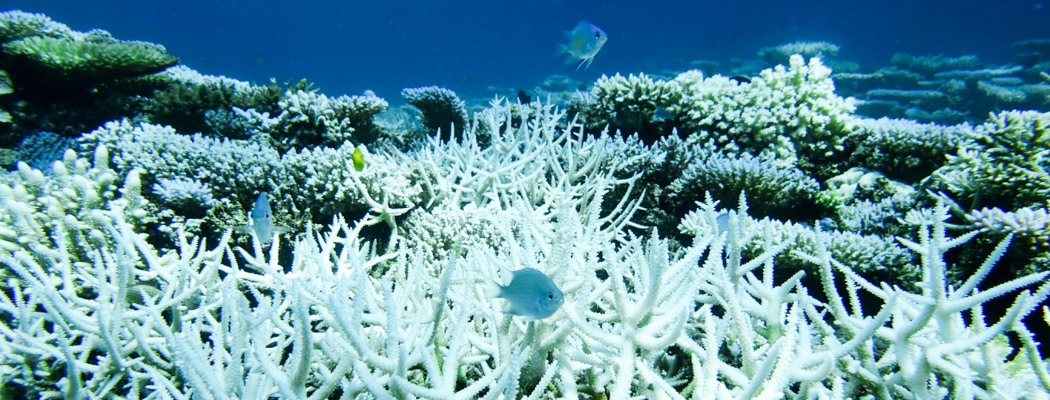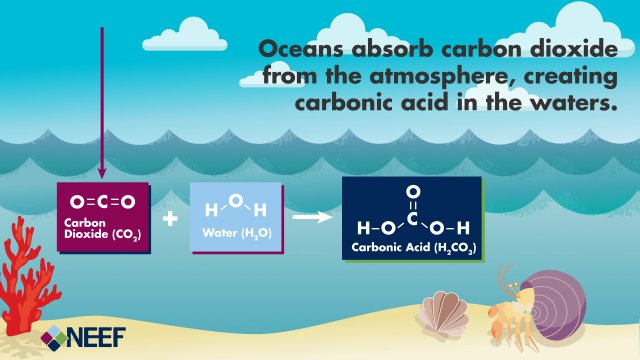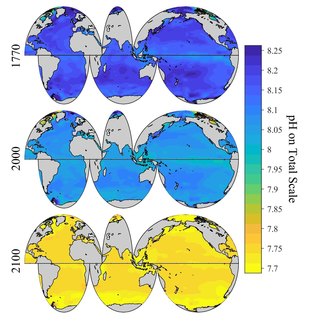We can see the effects of climate change in many ways: increased forest fires, more extreme seasonal temperatures, more dramatic weather events. But rarely do we think about the effect of a warming climate on ecosystems that aren’t as closely connected to our own world—like the ocean.
The ocean plays a critical role in climate change mitigation; we would all be living (or not) on a ball of fire by now if it weren’t for the ocean. In fact, the majority of our carbon emissions are stolen by the ocean, which absorbs 30% of the carbon dioxide (CO2) that humans emit.
While this is great news for us, it’s not so great for creatures living in the oceans.

Acidifcation’s Effect on Corals and Shellfish
Climate change is affecting the ocean and its inhabitants in two ways.
First, the ocean is warming, just like the rest of the planet. Many people, when thinking about how climate change is affecting the ocean think of coral bleaching. When ocean temperatures rise, the microorganisms that live on coral vacate. Because these microorganisms are the source of coral’s color, when they leave, you see coral’s calcium carbonate skeleton, which is white.
Secondly, the increased CO2 causes acidification. The CO2 emissions that cause climate change dissolve into the ocean, where they chemically combine with water molecules. This produces carbonic acid, which lowers the pH of the ocean, making it more acidic.

Since preindustrial times, the ocean’s pH has decreased from 8.2 to 8.1. Even though this may not seem like a lot, the pH scale is logarithmic, which means that the ocean is now 25% more acidic.
Acidification’s Effect on Young Fish
The ocean’s lower pH also affects many ocean animals. Young fishes’ ability to smell, for example, is decreased by ocean acidification. Young fish rely on smells for various things, like finding food or their parents, and also avoiding predators.
Studies have found that when fish hatch into waters that are more acidic than the ocean average of 8.1, their sense of smell starts to fail. Young clownfish were unable to identify their predators’ smell and in some cases were even attracted to it. They also no longer did their little predator dances to alert other fish that there was a predator around.
Similarly, the young fish could no longer discern between their parents’ scent and other fish and in some cases were more attracted to the smell of foreign fish than their own parents. In these studies, when the pH was lowered even just a little bit more, the young fish lost their sense of smell completely.
All of these changes affect how long fish live. If they can longer find their parents to receive parental care or avoid predators that want to eat them, many young fish do not live to adulthood. It won’t take many generations of early death before fish populations decline dramatically.
Acidification’s Effect on Adult Fish
Young fish aren’t the only ones affected by ocean acidification. Young fish don’t ever leave their part of the reef, but adult fish do spend time outside of their home reefs.
They rely on smell, as well as hearing to a lesser extent, to find their homes again when they’re done foraging. But much like their babies, adults’ ability to smell decreases with increasing ocean acidity.
Even with just slightly decreased pH levels, studies showed that adult fish were substantially less likely to be able to return to their home reefs, even after three days of trying. In scenarios of further decreased pH levels, only 32% of adult fish were able to find their way back to their home reef after three days.
So not only are young fish not growing up but adult fish are getting lost and not returning home to mate or tend to their families and protect their young.
A CO2 Diet Plan for the Ocean
So what can we do for the fish? Because their situation is so heavily tied to climate change, mitigation methods that don’t address climate change may not be effective. Under the most severe climate change scenario, the “business as usual” scenario, oceans will continue to warm and pH will decrease substantially.

Because the ocean absorbs one-third of total CO2 emitted, emissions will need to be reduced greatly to see any mitigation for the ocean.
One way to bolster climate change regulations and ensure that reefs receive the protection they need is to designate these areas as marine protected areas (MPA).
Under designation as an MPA, oceans surrounding reefs would be frequently sampled to monitor their temperature, pH, and other vital parameters. Activities within an MPA can also be restricted, meaning that fishing, oil rigs, or other exploitative industries would not be allowed within the boundaries of the MPA. Under legal protection, any person or corporation that harms the MPAs could be sued.
Constantly monitoring the health of the ocean and restricting the use of the area would increase the resilience of the reefs, protecting them against the effects of climate change even if CO2 emissions are not decreased.
